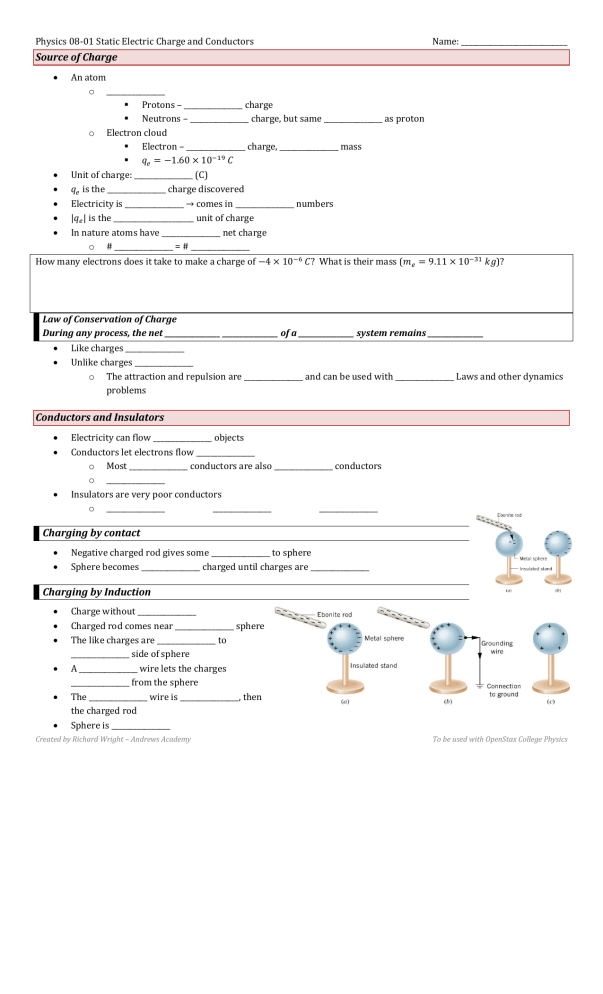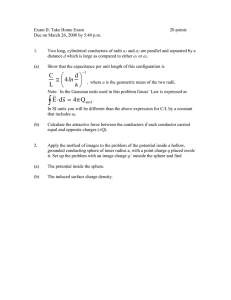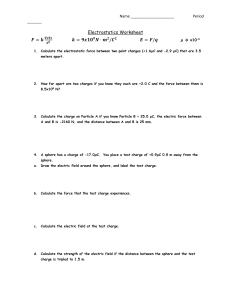
Physics 08-01 Static Electric Charge and Conductors Name: _____________________________ Source of Charge An atom o ________________ Protons – ________________ charge Neutrons – ________________ charge, but same ________________ as proton o Electron cloud Electron – ________________ charge, ________________ mass 𝑞𝑒 = −1.60 × 10−19 𝐶 Unit of charge: ________________ (C) 𝑞𝑒 is the ________________ charge discovered Electricity is ________________ → comes in ________________ numbers |𝑞𝑒 | is the ______________________ unit of charge In nature atoms have ________________ net charge o # ________________ = # ________________ How many electrons does it take to make a charge of −4 × 10−6 𝐶? What is their mass (𝑚𝑒 = 9.11 × 10−31 𝑘𝑔)? Law of Conservation of Charge During any process, the net ________________ ________________ of a ________________ system remains ________________ Like charges ________________ Unlike charges ________________ o The attraction and repulsion are ________________ and can be used with ________________ Laws and other dynamics problems Conductors and Insulators Electricity can flow ________________ objects Conductors let electrons flow ________________ o Most ________________ conductors are also ________________ conductors o ________________ Insulators are very poor conductors o ________________ ________________ ________________ Charging by contact Negative charged rod gives some ________________ to sphere Sphere becomes ________________ charged until charges are ________________ Charging by Induction Charge without ________________ Charged rod comes near ________________ sphere The like charges are ________________ to ________________ side of sphere A ________________ wire lets the charges ________________ from the sphere The ________________ wire is ________________, then the charged rod Sphere is ________________ Created by Richard Wright – Andrews Academy To be used with OpenStax College Physics Physics 08-01 Static Electric Charge and Conductors Name: _____________________________ If the sphere was ________________ instead of metal o Electrons ________________ flow o The surface would become ________________ charged as the electrons in each individual atom rearrange, but no ________________ effect o ________________ cling is made by this ________________ Homework 1. There are very large numbers of charged particles in most objects. Why, then, don’t most objects exhibit static electricity? 2. An eccentric inventor attempts to levitate by first placing a large negative charge on himself and then putting a large positive charge on the ceiling of his workshop. Instead, while attempting to place a large negative charge on himself, his clothes fly off. Explain. 3. When a glass rod is rubbed with silk, it becomes positive and the silk becomes negative—yet both attract dust. Does the dust have a third type of charge that is attracted to both positive and negative? Explain. 4. Describe how a positively charged object can be used to give another object a negative charge. What is the name of this process? 5. What is grounding? What effect does it have on a charged conductor? On a charged insulator? 6. A metallic object is given a positive charge by induction. (a) Does the mass of the object increase, decrease, or remain the same? Why? (b) What happens to the mass of the object if it is given a negative charge by induction? 7. Common static electricity involves charges ranging from nanocoulombs to microcoulombs. (a) How many electrons are needed to form a charge of –2.00 nC (b) How many electrons must be removed from a neutral object to leave a net charge of 0.500 μC? (OpenStax 18.1) 𝟏. 𝟐𝟓 × 𝟏𝟎𝟏𝟎 electrons, 𝟑. 𝟏𝟑 × 𝟏𝟎𝟏𝟐 electrons 8. If 1.80 × 1020 electrons move through a pocket calculator during a full day’s operation, how many coulombs of charge moved through it? (OpenStax 18.2) -28.8 C 9. To start a car engine, the car battery moves 3.75 × 1021 electrons through the starter motor. How many coulombs of charge were moved? (OpenStax 18.3) -600 C 10. A certain lightning bolt moves 40.0 C of charge. How many fundamental units of charge |𝑞𝑒 | is this? (OpenStax 18.4) 𝟐. 𝟓𝟎 × 𝟏𝟎𝟐𝟎 11. Suppose a speck of dust in an electrostatic precipitator has 1.0000 × 1012 protons in it and has a net charge of –5.00 nC (a very large charge for a small speck). How many electrons does it have? (OpenStax 18.5) 1.03× 𝟏𝟎𝟏𝟐 12. An amoeba has 1.00 × 1016 protons and a net charge of 0.300 pC. (a) How many fewer electrons are there than protons? (b) If you paired them up, what fraction of the protons would have no electrons? (OpenStax 18.6) 𝟏. 𝟖𝟖 × 𝟏𝟎𝟔 , 𝟏. 𝟖𝟖 × 𝟏𝟎−𝟏𝟎 13. Consider three identical metal spheres, A, B, and C. Sphere A carries a charge of +5q. Sphere B carries a charge of –q. Sphere C carries no net charge. Spheres A and B are touched together and then separated. Sphere C is then touched to sphere A and separated from it. Last, sphere C is touched to sphere B and separated from it. (a) How much charge ends up on sphere C? What is the total charge on the three spheres (b) before they are allowed to touch each other and (c) after they have touched? (Cutnell 18.5) 1.5q, 4q, 4q Created by Richard Wright – Andrews Academy To be used with OpenStax College Physics



